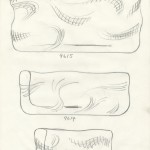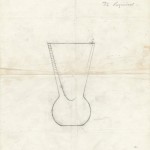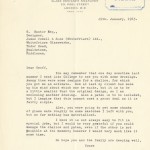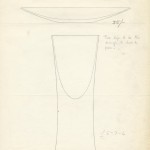Read about the grant that The Rakow Research Library of The Corning Museum of Glass recently received to help conserve and digitize the Whitefriars Collection of stained glass cartoons.
In August 2014, the Rakow Library acquired a small collection of Whitefriars Glass Ltd. items from Fieldings Auctioneers Ltd. The materials in this collection reflect 20th century post-war design at Whitefriars Glass, a British company that began producing glass in the early 18th century. Items in the collection include design work for Whitefriars by independent glass designer Jane Webster, and correspondence between Webster and artists William Wilson and Geoffrey Baxter in the 1950s and 1960s. Also among the items are a number of preproduction design drawings of pieces for the popular Knobbly range by William Wilson and Harry Dyer.
The Whitefriars glasshouse, located originally in London’s Whitefriars area, first produced flint glass tableware beginning around 1730. After purchase in 1834 by James Powell, the company was renamed James Powell & Sons, but would remain known colloquially as Whitefriars. The company began building a solid reputation as a premier glass manufacturer, and in 1844, Whitefriars complemented production of fine domestic glassware with the addition of a stained glass studio. Capitalizing on the Victorian-era push to refurbish existing and build new Church of England churches in gothic revival style, Whitefriars’ studio soon earned a reputation as makers of fine ecclesiastical stained glass. High profile artists such as Edward Burne-Jones, Walter Crane and Henry Holiday were commissioned to design windows for the company. Well-known architects involved with the Powells’ studio included William Butterfield, Richard Cromwell Carpenter, and Sir George Gilbert Scott, a leading gothic revival architect.
The Powells were innovators, engaging avant-garde artists to provide designs, and incorporating scientific research and experimental methods to continually improve the quality of their glass. A lack of popularity for stained glass in the early to mid-1800s meant that few companies were producing it, and quality was poor. Whitefriars particularly benefitted in the 1850s from a collaboration with stained glass historian Charles Winston (1814 – 1864), who studied the composition of medieval stained glass and led the Powells to develop new techniques in colored glassmaking.
- Whitefriars Knobbly Range, patterns 9613, 9614, 9615, designed by William Wilson and Harry Dyer, ca. 1964 (CMGL 141804).
- Whitefriars cased glass design, probably by Geoffrey Baxter, 1960s (CMGL 141803).
By the 1890s, Whitefriars had embraced both the Arts and Crafts and Art Nouveau aesthetics. Powell designs of this era played a prominent and important role in both movements, diverging from the designs of contemporary glass studios such as Gallé and Tiffany with unique forms of expression.
In 1919 the company changed its name once again, to James Powell and Sons (Whitefriars) Ltd. Prospering, in 1923 the company relocated to a larger, state-of-the-art factory building in Wealdstone, Middlesex. The company continued to thrive during the interwar years, but business dwindled after 1945. A decade later, Whitefriars once again flourished, and in the 1950s was named an outstanding British industry. In the 1950s, 1960s and 1970s, high-profile artists such as William Wilson, James Hogan, Geoffrey Baxter and Peter Wheeler designed glassware for the company, creating popular lines such as the knobbly range, the “bark” series and the Peacock Studio Range.
- Letter from E.J. Webster to Geoffrey Baxter of Whitefriars, 1963 (CMGL 141799).
- Whitefriars chalice and paten design for E. J. Webster, 1963 (CMGL 141801).
The proliferation of poor-quality and machine-produced imitations, combined with a diminishing market for artistic glassware, gave rise to an increasingly unfavorable economic climate for the company by the 1970s. The stained glass studio closed in 1973, and although Whitefriars had been producing cut glass to offset losses in artistic glassware sales, the company eventually succumbed to market forces. In 1980, Whitefriars closed its doors, ending nearly 150 years of innovation and cutting edge design. Under the steerage of three generations of the Powell family, Whitefriars remained on the forefront of glassmaking and design, attracting leading artists and designers, and demonstrating a keen perception of social, political and aesthetic shifts.
Read more about the company and our Whitefriars collections in previous posts.
The Rakow Research Library is open to the public 9am to 5pm every day. We encourage everyone to explore our collections in person or online. If you have questions or need help with your research, please use our Ask a Glass Question service.





